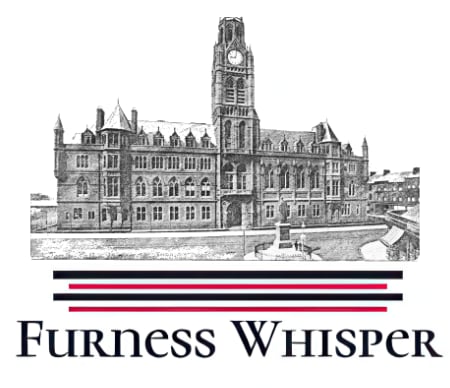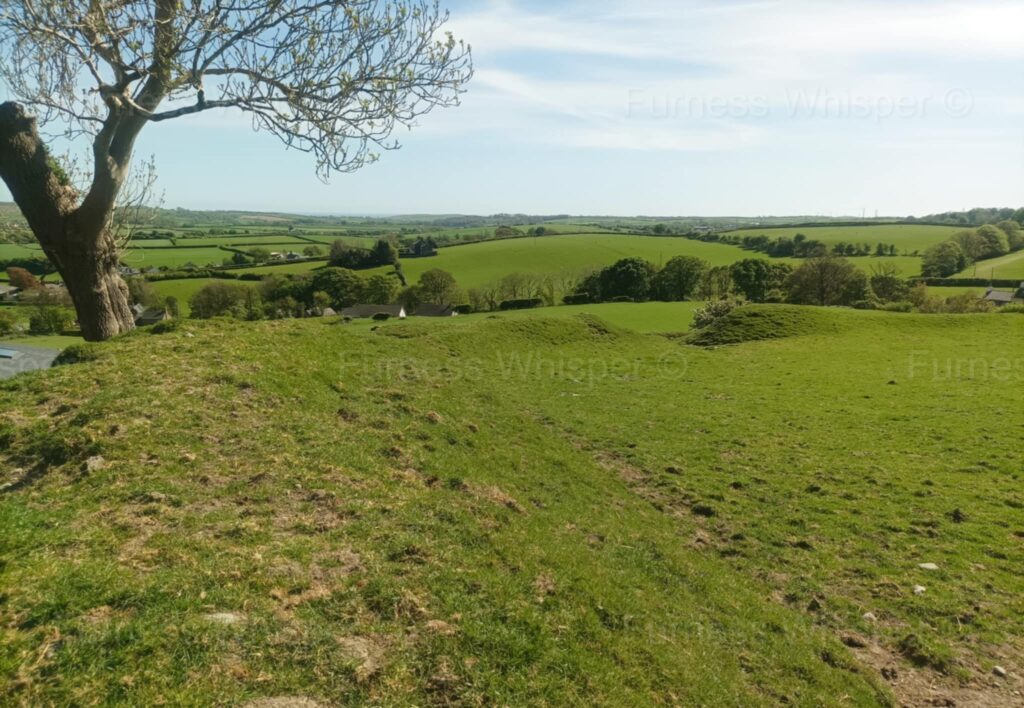
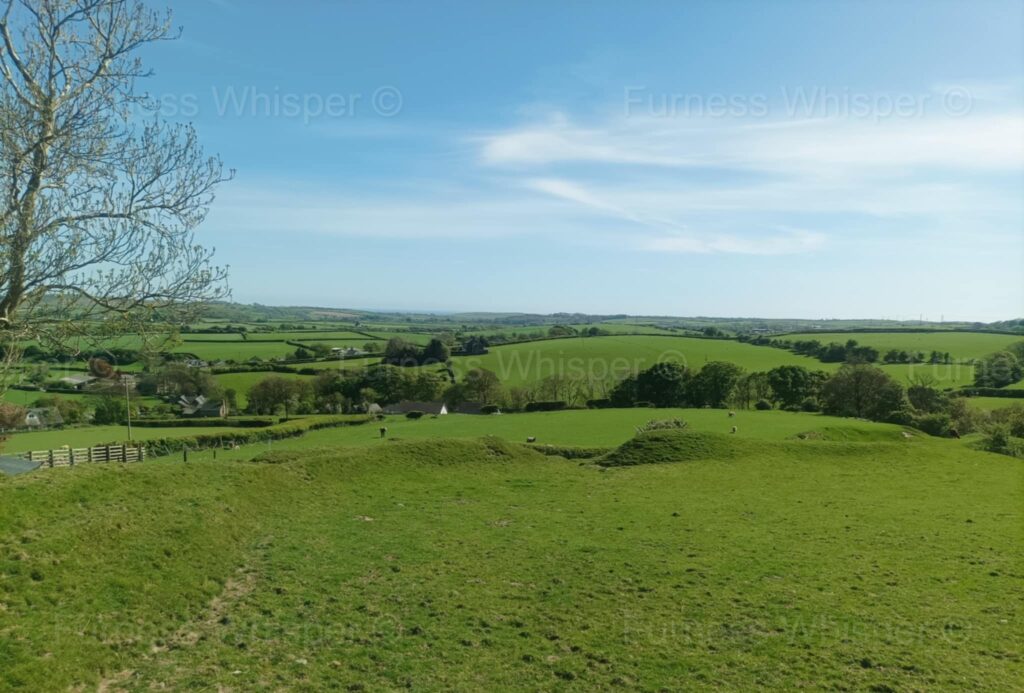
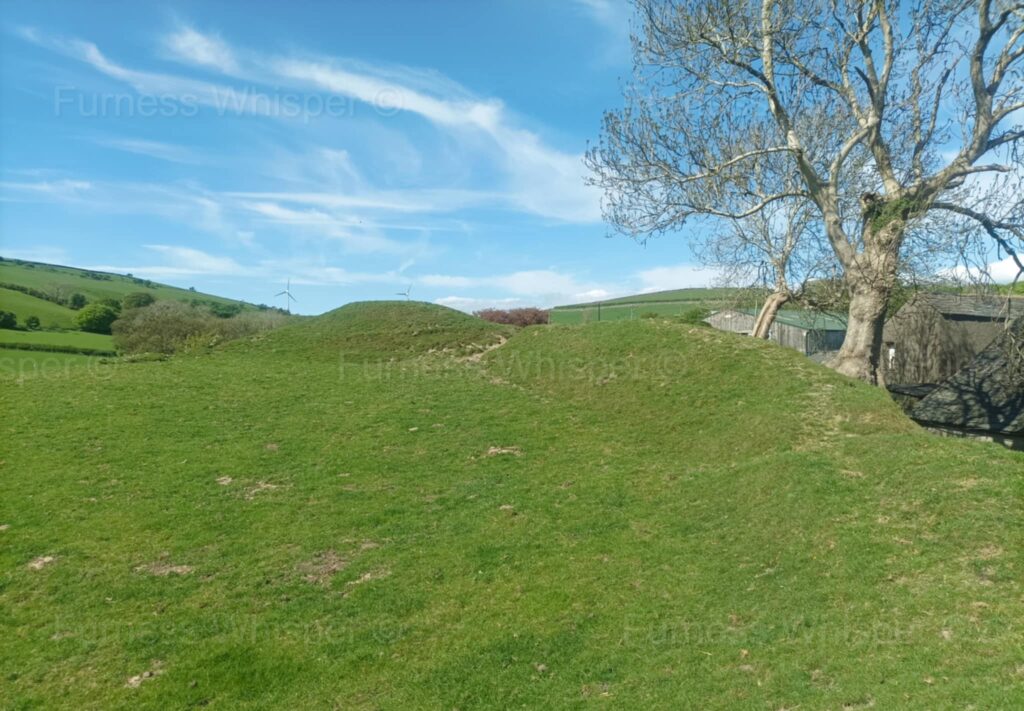
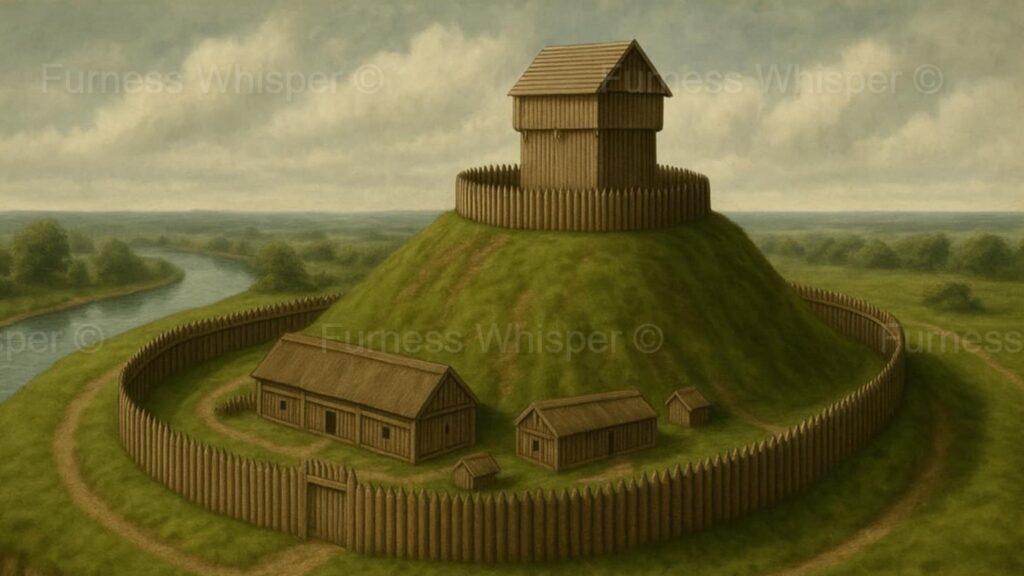
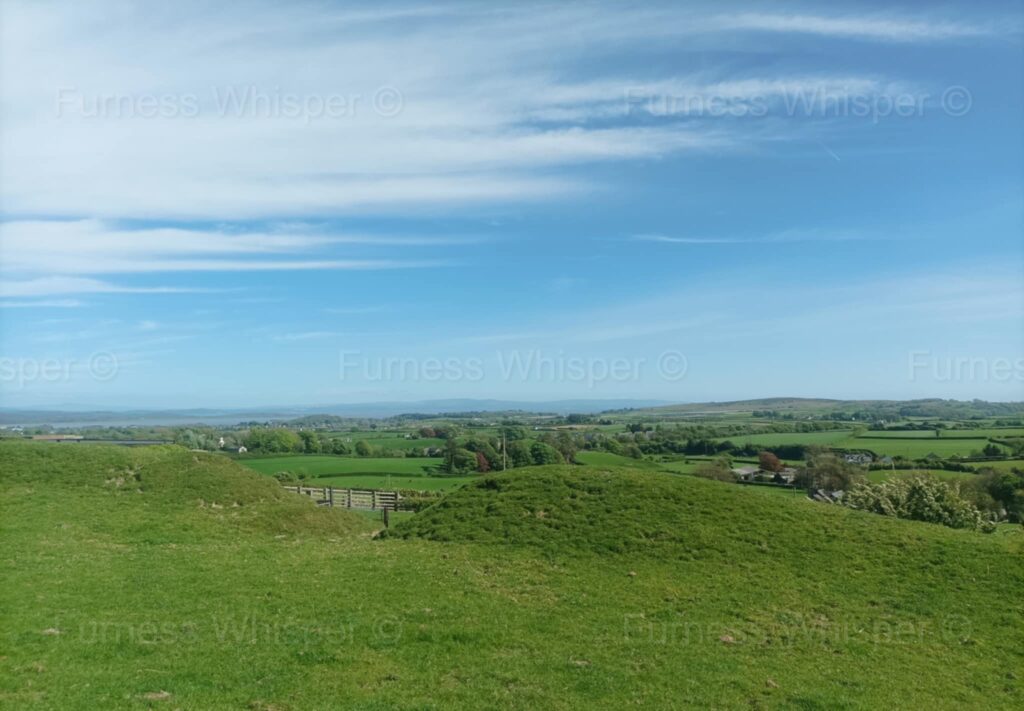
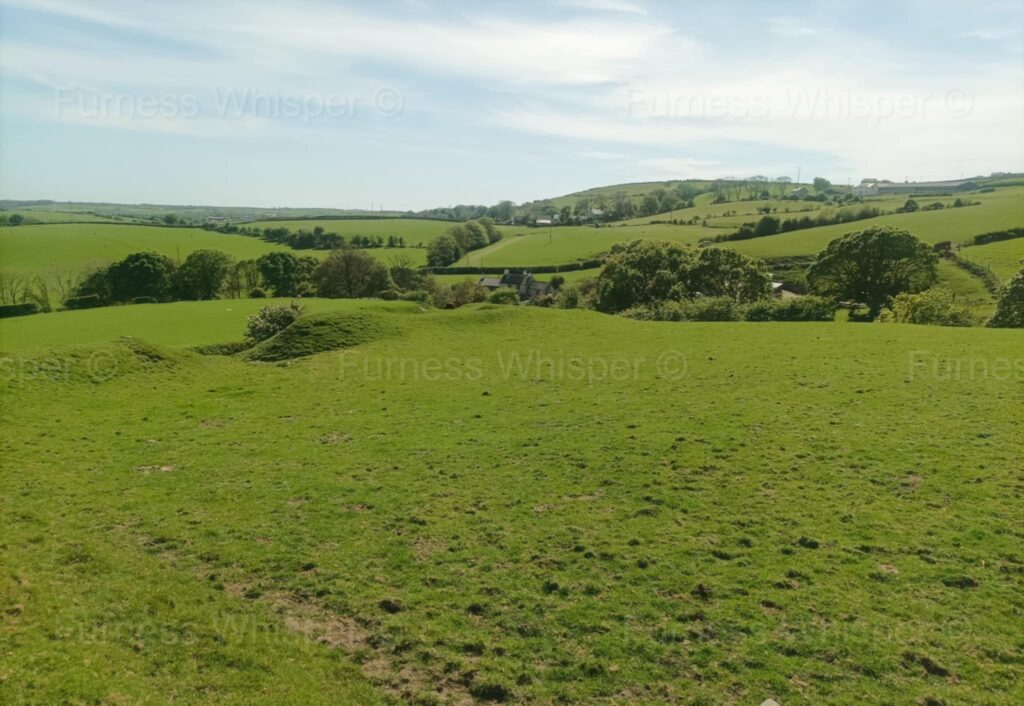
One of the images is not the castle; it is what it may have looked like based on the historical description.
Priories, Penningtons, and Early Foundations
In the medieval wilds of Furness, long before Muncaster’s towers rose by the River Esk, the Pennington family established deep roots. Their story begins in the 12th century at Pennington, a village near Ulverston in the Furness Peninsula. Here, the family’s early forebears held lands and exercised lordship. Local tradition even credits Gamel de Pennington, an early member of the lineage, with helping found nearby Conishead Priory around 1160. This Augustinian priory, situated just south of Ulverston, benefited from Pennington patronage, marking one of the family’s first notable contributions to the region’s spiritual and cultural life. These early connections between the Penningtons and the church foreshadowed the family’s prominent role in Furness, setting the stage for the construction of their own fortified residence at Castle Hill.
Pennington Castle at Castle Hill: The First Stronghold in Furness
By the late 12th or early 13th century, the Pennington lords had fortified their home at Castle Hill, a strategic knoll that offered commanding views over the rolling countryside and towards Morecambe Bay. The site, known today as Pennington Castle Hill, was the location of Pennington Castle, the family’s ancestral stronghold. Though little remains above ground now except grassy earthworks, one can imagine the scene centuries ago: a timber palisade crowning the steep motte (mound), encircled by a protective ditch, with a simple hall or tower at its crest to serve as the lord’s residence.
Within the bailey at the foot of the mound, wooden outbuildings and cottages of retainers huddled behind earth ramparts. On blustery Cumbrian nights, flickering lamplight from the castle would have glowed across the dark fields. By day, the lord of Pennington could survey his domain—fertile fields, wooded valleys, and the distant glint of the sea—from this modest yet important fortress. Pennington Castle was likely built in the Norman style (a motte-and-bailey design) to secure the Penningtons’ manor in the decades after the Norman Conquest. The Penningtons, as local landholders, owed fealty to greater regional lords (such as the Barons of Kendal or the Abbot of Furness) and needed a defensible home. Though historical records about Pennington Castle are sparse, its very existence at Castle Hill testifies to the Penningtons’ status as one of the dominant medieval families of Furness. Not only did they provide land for religious foundations, but they also maintained this fortified seat, from which they likely administered justice and managed their estates. However, by the early 13th century, the ambitions of the Pennington family extended beyond Furness. A new chapter was about to begin at a place called Muncaster, which would eclipse the old Castle Hill stronghold in splendour and significance.
Archaeological Insights into Castle Hill
Recent archaeological work has provided intriguing insights into the structure and use of Castle Hill. The Cumbria Historic Environment Record (HER) describes the earthworks at Castle Hill as forming an artificial enclosure, with a square shape measuring approximately 156 x 132 feet. The ditch surrounding the site is reported to be around 45 feet wide, with the rampart on the northern side reaching a height of about 12 feet. Notably, a precipitous slope forms the north-west and south-west sides of the enclosure, and the strongest defences are located on the northern side. A breach on the southern side is believed to have been the original entrance.
The HER also highlights some significant archaeological findings, including traces of a kiln built into the southern rampart and a fulling mill near the site. Excavations in 1926, though disappointing in their results, uncovered only a small piece of flint, which may have been worked but in a very rudimentary manner. A more recent watching brief in 2020 uncovered a shell midden and a possible cess pit, which were associated with a sherd of late medieval pottery. These findings suggest that the ringwork at Castle Hill was likely abandoned by the 14th century.
In 2023, another watching brief during construction activities at Castle Hill Farm revealed a wall of probable post-medieval origin, but nothing else of note was found. These findings reinforce the idea that the ringwork had fallen out of use by the 14th century, aligning with the fact that the Penningtons had already moved their principal residence to Muncaster Castle by that time.
Despite these limited findings, the evidence from Castle Hill reinforces the idea of a once-defensible site that eventually became obsolete as the Penningtons expanded their holdings and moved their focus to Muncaster.
From Furness to Cumberland: The Move to Muncaster Castle
In the 1200s, the Pennington family’s influence expanded northward into Cumberland. The Muncaster estate, on the Esk river near Ravenglass, entered the Pennington story at this time. In fact, records indicate that Alan de Penitone (a Latinised form of Pennington) was granted the lands of Muncaster in 1208. This royal or feudal grant marked a turning point: the Penningtons now held a valuable estate on the north-west fringe of the Lake District, a region that, while remote, lay on important routes between England and Scotland. Here, the family established a second stronghold—Muncaster Castle—which would become their principal seat in generations to come.
Muncaster Castle’s early incarnation was likely a fortified manor house. The Penningtons built a great hall at Muncaster, probably in the 13th century, using stone for more permanence and defence than their timber Castle Hill motte. Over time, they augmented Muncaster’s defences to address the frequent unrest on the English-Scottish border. By the 14th century, a sturdy pele tower (a tall, thick-walled defensive tower typical of border castles) had been added at Muncaster. This gave the castle a formidable look—a rectangular stone tower for refuge and vigilance, from which watchers could spot any approaching reivers or hostile forces. The castle’s location itself was defensible and picturesque: perched on a hill overlooking the River Esk’s valley and the Irish Sea coast, with the mountains of the Lake District forming a dramatic backdrop.
As generations passed, Muncaster Castle grew from a medieval fortress into a comfortable family seat. The Penningtons did not abandon their ancestral lands in Pennington; those would continue to be part of their holdings, but Muncaster became the heart of their domain. In shifting their main residence from Castle Hill to Muncaster, the Penningtons moved from a relatively rudimentary motte-and-bailey to a more substantial stone castle—reflecting their rising status and the greater security concerns of the borderlands. The old Pennington Castle may have gradually fallen out of use after the 13th century, its timber structures decaying and leaving behind only the grassy mound we see today. Meanwhile, at Muncaster, the Penningtons were writing new chapters of history that intertwined with national events.
The Pennington Family Tree: Linking Castle Hill to Muncaster
Tracing the Pennington family tree reveals an unbroken line connecting the humble motte at Castle Hill with the grandeur of Muncaster Castle. Below is a simplified chronology of key family members and how they link the two seats:
- Gamel de Pennington (fl. mid-12th century) – The earliest recorded Pennington. He held lands in Furness, and by tradition, was a benefactor (and possibly founder) of Conishead Priory. Gamel’s influence in the 1100s establishes the Penningtons as local lords in the Pennington/Ulverston area, setting the stage for their castle at Castle Hill. It is likely that either Gamel or his immediate heirs were responsible for erecting the motte-and-bailey fortifications on Castle Hill to secure their manor.
- Alan de Penitone (de Pennington) (fl. early 13th century) – A descendant of Gamel (perhaps his grandson or great-grandson), Alan is a pivotal figure who bridges Pennington and Muncaster. In 1208, Alan de Penitone was granted the Muncaster estate in Cumberland. This grant brought the Penningtons a new lordship far from their Furness home. Alan presumably maintained the Pennington lands (and Castle Hill stronghold) while establishing a residence at Muncaster. He likely constructed the initial hall at Muncaster Castle, making him the progenitor of the Penningtons of Muncaster. From Alan onward, the family would often be known as the Penningtons “of Muncaster,” even as they retained their ancestral surname derived from Pennington village.
- Sir John de Pennington (15th century) – A medieval knight and lord of Muncaster Castle, Sir John is celebrated for a dramatic episode in the Wars of the Roses. After the disastrous Lancastrian defeat at the Battle of Towton in 1461, England’s fugitive King Henry VI found refuge at Muncaster. Sir John de Pennington loyally sheltered the deposed king. In gratitude, Henry VI reputedly bestowed upon the family a remarkable gift: a finely crafted Venetian glass drinking bowl, along with a blessing: “As long as this bowl remains unbroken, Penningtons from Muncaster never shall be driven.” This treasure became known as “The Luck of Muncaster,” a talisman said to guarantee the family’s fortunes. Remarkably, the glass survives intact to this day, a tangible link to Sir John’s loyalty and the family’s enduring good fortune. Sir John’s era also likely saw the strengthening of Muncaster’s defences (including the pele tower) as the Penningtons navigated the perils of 15th-century border wars and political upheavals.
- Sir Alan Pennington (16th century) – A later medieval or Tudor-era lord of Muncaster, Sir Alan is notable in local lore as the father of Helwise Pennington, a young heiress who features in the legend of Tom Fool. Thomas Skelton, known as “Tom Fool,” was a jester in the Pennington household reputed to have lived in the early 17th century. According to legend, Tom Fool carried out a dark deed at Sir Alan’s behest—the beheading of an unsuitable suitor to Helwise—earning him notoriety as the “original” fool or jester archetype. While the tale is semi-legendary, it underscores the Penningtons’ place in local folklore and the colourful characters attached to their family history. A portrait of Tom Fool hangs in Muncaster Castle, and the story of Sir Alan and Helwise adds a ghostly intrigue to the family tree.
- The Penningtons as Barons Muncaster (18th–19th centuries) – As the centuries progressed, the Pennington family continued to thrive and adapted to the changing times. In the Georgian and Victorian eras, they were elevated from the rank of country squires to the peerage. The head of the family was created Baron Muncaster, reflecting the family’s prominence. For example, in the late 18th century, a Sir John Pennington (a descendant of the medieval knights) sat in Parliament and was raised to the peerage as the 1st Baron Muncaster (in the Peerage of Ireland), and his successors later held a Baron Muncaster title in the Peerage of the United Kingdom.
- Modern Descendants – In the 20th and 21st centuries, the descendants of the Penningtons have maintained Muncaster Castle as a lived-in home and a heritage site. Notably, Phyllida Gordon-Duff-Pennington, a direct descendant, and her husband Patrick devoted themselves to restoring the castle in the late 20th century. Their children and grandchildren (such as the Frost-Pennington family) still reside at Muncaster, representing the 32nd generation (approximately) of the Pennington line from the Middle Ages.
Sharon’s Insights: The Legacy at Castle Hill and Muncaster
I recently received an enlightening reply from Sharon, the Curator of Muncaster Castle, who kindly shared some of her knowledge about Pennington Castle Hill. Sharon noted that the runic tympanum dedicated to Gamel de Penitone—often associated with the founding of Pennington Church—still stands at the site. This discovery is a fascinating link between the Pennington family and their spiritual and territorial roots. Sharon also mentioned the possibility of an ancient hall at Beckside, which adds further intrigue to the area’s history. Sharon also clarified that the Pele tower at Muncaster was the first structure built there following the charter of King John in 1208, with folklore suggesting that the Penningtons may have first settled in the Bath House before moving to the Pele tower. Sharon even mentioned that medieval tiles were found at the Bath House, which might be tantalising clues about its use.
Conclusion: An Enduring Heritage from Castle Hill to Muncaster
Standing on the windswept Castle Hill today, with the remnants of Pennington’s first castle barely perceptible underfoot, it takes a leap of imagination to picture the sounds and sights of medieval life that once animated this knoll – the clatter of hooves on the drawbridge, the ring of a blacksmith’s hammer from the bailey, or the chant of monks drifting from nearby Conishead Priory. Yet this very spot was the cradle of a family line that not only survived but flourished over centuries.
At Muncaster, the weight of ages is tangible: in the thick stone walls that have never fallen, in the treasured glass bowl given by a grateful king, and in the very name of the occupants – Pennington – which is the same now as it was when a Pennington first climbed Castle Hill to survey his lands so many years ago.
The link between Pennington Castle and Muncaster Castle is more than just a family connection; it is a story of continuity and adaptation. It’s a journey from a wooden palisade on a hillock to a splendid castle celebrated in travel guides, from medieval knights to modern conservationists, all in one family.
For history enthusiasts, this tale offers a vivid glimpse into how local and national history interweave. The Penningtons of Pennington and Muncaster show us how a noble family could shape and be shaped by the events around them – founding priories, building fortresses, aiding kings, enduring civil wars, and embracing the responsibilities of modern estate management. Their story is etched into the very landscape of Cumbria: Castle Hill remains a scheduled monument preserving the footprint of their first home, and Muncaster Castle thrives as a Grade I listed historic house, open to visitors and still owned by the same bloodline.
In the words of one 15th-century blessing, “Penningtons from Muncaster never shall be driven” – and indeed, the Penningtons are very much still there. Whether one walks the green mound at Pennington or the sumptuous halls of Muncaster, the legacy of this family comes alive through the tangible settings and the well-preserved stories passed down through generations. It is a legacy that continues to captivate, offering a rich narrative of feudal loyalties, architectural endeavours, familial perseverance, and the sweep of English history from the Middle Ages to the present day.
A special thank you to Sharon, Curator of Muncaster Castle, for her valuable insights and the time she took to share her knowledge. Your contributions have greatly enhanced this exploration of the Pennington family history.
